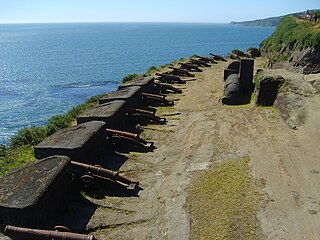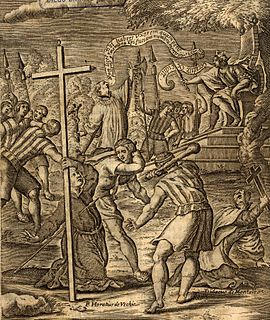
The Biobío River is the second largest river in Chile. It originates from Icalma and Galletué lakes in the Andes and flows 380 km to the Gulf of Arauco on the Pacific Ocean.

The Arauco War was a long-running conflict between colonial Spaniards and the Mapuche people, mostly fought in the Araucanía. The conflict began at first as a reaction to the Spanish conquerors attempting to establish cities and force Mapuches into servitude. It subsequently evolved over time into phases comprising drawn-out sieges, slave-hunting expeditions, pillaging raids, punitive expeditions, and renewed Spanish attempts to secure lost territories. Abduction of women and war rape was common on both sides.
The Royal Governor of Chile ruled over the Spanish colonial administrative district called the Captaincy General of Chile, and as a result the Royal Governor also held the title of a Captain General. There were 66 such governors or captains during the Spanish conquest and the later periods of Spanish-centered colonialism. Since the first Spanish–Mapuche parliaments in the 17th century it became an almost mandatory tradition for each governor to arrange a parliament with the Mapuches.

Don Martín García Óñez de Loyola was a Spanish Basque soldier and Royal Governor of the Captaincy General of Chile. According to Diego Barros Arana it is likely that Ignatius of Loyola was his uncle.

The Fort System of Valdivia are a series of Spanish colonial fortifications at Corral Bay, Valdivia and Cruces River established to protect the city of Valdivia, in southern Chile. During the period of Spanish rule (1645–1820), it was one of the biggest systems of fortification in the Americas. It was also a major supply source for Spanish ships that crossed the Strait of Magellan.

Bueno River is a river in southern Chile. It originates in Ranco Lake and like most of Chile rivers it drains into the Pacific Ocean at the southern boundary of the Valdivian Coastal Reserve. Its lower flow forms the border between Osorno Province and Ranco Province. Traditionally it marks also the northern boundary of the indigenous Huilliche territory known as Futahuillimapu. The river passes through Río Bueno commune and city that takes name from the river.
The Battle of Penco, on March 12, 1550 was a battle between 60,000 Mapuche under the command of their toqui Ainavillo with his Araucan and Tucapel allies and Pedro de Valdivia's 200 Spaniards on horse and afoot with many yanakuna including 300 Mapochoes auxiliaries under their leader Michimalonco, defending their newly raised fort at Penco. It was part of a war.

Pehuenche are an indigenous people of South America. They live in the Andes, primarily in present-day south central Chile and adjacent Argentina. Their name derives from their dependence for food on the seeds of the pehuen or monkey-puzzle tree. In the 16th century, the Pehuenche lived in the mountainous territory from approximately 34 degrees to 40 degrees south. Later they became Araucanized and partially merged with the Mapuche peoples. In the 21st century, they still retain some of their ancestral lands.

The Battle of Lagunillas was a battle in the Arauco War on November 8, 1557, between the army of García Hurtado de Mendoza and the Mapuche army near some shallow lakes a league south of the Bio-Bio River.
In Chilean historiography, Colonial Chile is the period from 1600 to 1810, beginning with the Destruction of the Seven Cities and ending with the onset of the Chilean War of Independence. During this time, the Chilean heartland was ruled by Captaincy General of Chile. The period was characterized by a lengthy conflict between Spaniards and native Mapuches known as the Arauco War. Colonial society was divided in distinct groups including Peninsulars, Criollos, Mestizos, Indians and Black people.
As an archaeological culture, the Mapuche people of southern Chile and Argentina have a long history which dates back to 600–500 BC. The Mapuche society underwent great transformations after Spanish contact in the mid–16th century. These changes included the adoption of Old World crops and animals and the onset of a rich Spanish–Mapuche trade in La Frontera and Valdivia. Despite these contacts Mapuche were never completely subjugated by the Spanish Empire. Between the 18th and 19th century Mapuche culture and people spread eastwards into the Pampas and the Patagonian plains. This vast new territory allowed Mapuche groups to control a substantial part of the salt and cattle trade in the Southern Cone.

The Defensive War was a strategy and phase in the Arauco War between Spain and independent Mapuches. The idea of the Defensive War was conceived by Jesuit father Luis de Valdivia who sought to diminish hostilities, establish a clear frontier and increase missionary work among the Mapuches. Luis de Valdivia believed the Mapuches could be voluntarily converted to Christianity only if there was peace.
The battle of Río Bueno was fought in 1654 between the Spanish Army of Arauco and indigenous Cuncos and Huilliches of Fütawillimapu in southern Chile. The battle took place against a background of a long-running enmity between the Cuncos and Spanish, dating back to the destruction of Osorno in 1603. More immediate causes were the killing of Spanish shipwreck survivors and looting of the cargo by Cuncos, which led to Spanish desires for a punishment, combined with the prospects of lucrative slave raiding.
The Mapuche uprising of 1655 was a series of coordinated Mapuche attacks against Spanish settlements and forts in colonial Chile. It was the worst military crisis in Chile in decades, and contemporaries even considered the possibility of a civil war among the Spanish. The uprising marks the beginning of a ten-year period of warfare between the Spanish and the Mapuche.
The Salazar brothers were Spanish criollos who played important roles in mid-17th century affairs in the Captaincy General of Chile. They became infamous for their slave hunting expeditions, corruption and role in unleashing the Mapuche uprising of 1655.
The Parliament of Boroa was a diplomatic meeting held on January 24, 1651, between various Mapuche groups and Spanish authorities held in the fields of Boroa. The parliament was attended by the Governor of Chile Antonio Acuña Cabrera who travelled to Boroa incognito from the fortress of Nacimiento in the north accompanied only by six men. This riskful crossing of Mapuche territory was considered valiant but reckless stunt by Spanish subordinates.
Slavery of Mapuches was commonplace in 17th-century Chile and a direct consequence of the Arauco War. When Spanish conquistadors initially subdued indigenous inhabitants of Chile there was no slavery but a form servitude called encomienda. However, this form of forced labour was harsh and many Mapuche would end up dying in the Spanish gold mines in the 16th century.
The 1651 wreckage of San José and the subsequent killings and looting carried out by indigenous Cuncos was a defining event in Colonial Chile that contributed to Spanish-Cunco tensions that led to the Battle of Río Bueno and the Mapuche uprising of 1655.
Battle of Pudeto was an attack by Chilean patriots forces During the 1826 campaign on the Spanish stronghold of Chiloé in southern Chile. After landing in the northern coast Chiloé Island Supreme Director Ramón Freire planned a direct assault led by Jorge Beauchef on enemy positions during the night. Manuel Blanco Encalada and José Manuel Borgoño successfully convinced Freire to instead attempt weaken the royalists and presented a plan to capture three small gunboats. Freire conceded and Guillermo Bell was chosen for the task. Bell was able to successfully capture the gunboats despite being next to the fort of San Carlos.
Battle of Bellavista was the final confrontation of the Chilean 1826 campaign to dislodge the Royalists from Chiloé Archipelago. On January 13 Chilean forces were able to capture three small gun boats from the Royalists in Ancud in the Battle of Pudeto. The battle began in the morning of January 14 with a Chilean advance on Ancud. In face of this and the fire of naval and land-based artillery royalist troops retreated to the Fort of San Carlos. As the Chileans began to surround the Spanish positions Quintanilla ordered a retreat to the heights of Bellavista where he hoped to put up some resistance. However, the demoralised royalist troops were not in mood to fight so by late evening Quintanilla ordered a retreat south along the road to Castro. Agüi Fort in Lacuy Peninsula surrendered on January 15. Quintanilla capitulated on January 18 after negotiating the conditions.






